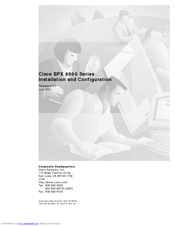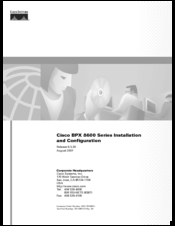Cisco BPX 8680-IP Manuals
Manuals and User Guides for Cisco BPX 8680-IP. We have 2 Cisco BPX 8680-IP manuals available for free PDF download: Installation And Configuration Manual
Cisco BPX 8680-IP Installation And Configuration Manual (630 pages)
Cisco BPX-BXM-155-8DX: User Guide
Table of Contents
-
-
Bpx 862046
-
Bpx 865047
-
Bpx 868048
-
Bpx 8680-Ip48
-
Table49
-
-
Discontinued50
-
-
Node Alarms77
-
-
Upgrades61
-
-
-
-
-
-
Features107
-
-
BXM Capabilities122
-
Enhanced BXM126
-
-
Table131
-
-
-
Drsiu144
-
Demux/Mux145
-
Rcmp145
-
Sabre145
-
Simba146
-
Port (UNI) Mode147
-
Physical Layer148
-
Trunk Mode148
-
-
-
Site Preparation157
-
Parts Checklist158
-
-
-
-
-
-
-
-
Card Slot Fuses202
-
Fan Power Fuses203
-
Fan Power Fuses204
-
-
-
-
Installing Tray206
-
-
-
-
-
-
-
Table264
-
-
-
-
Table294
-
-
Table298
-
-
Addcon Example300
-
-
-
Table296
-
BXM Connections297
-
VSVD Description297
-
-
Configuration306
-
-
Leaky Bucket 1341
-
Leaky Bucket 1346
-
ATM Command List352
-
-
Examples341
-
Advertisement
Cisco BPX 8680-IP Installation And Configuration Manual (606 pages)
Brand: Cisco
|
Category: Network Router
|
Size: 6.53 MB
Table of Contents
-
-
-
Upgrades67
-
Node Alarms85
-
-
Discontinued55
-
-
-
-
-
Features97
-
-
-
-
Features113
-
-
BXM Capabilities129
-
ATM Layer129
-
Service Types130
-
Enhanced BXM131
-
-
-
-
Drsiu150
-
Rcmp151
-
Sabre151
-
Simba152
-
Port Mode153
-
Trunk Mode154
-
Physical Layer156
-
Installation
159 -
-
Site Preparation165
-
Parts Checklist166
-
-
-
-
-
-
-
-
-
Card Slot Fuses215
-
Fan Power Fuses216
-
-
-
-
-
Installing Tray218
-
-
-
-
-
-
-
-
-
Line Commands290
-
-
Virtual Ports292
-
-

